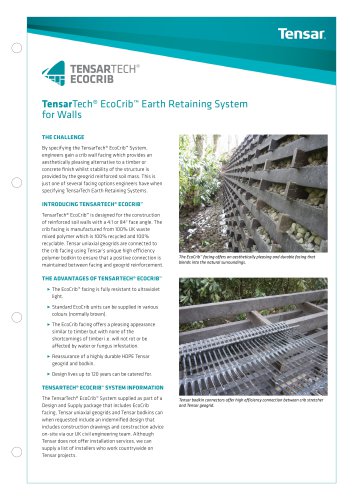Catalog excerpts
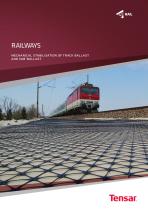
railways mechanical stabilisation of track ballast and sub-ballast
Open the catalog to page 1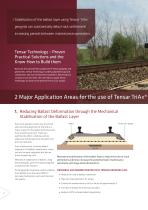
Stabilisation of the ballast layer using Tensar® TriAx® geogrids can substantially delay track settlement increasing periods between maintenance operations. Tensar Technology – Proven Practical Solutions and the Know-How to Build them Based on the characteristic properties of Tensar geogrids and geotextiles, Tensar Technology is widely adopted for ground stabilisation and soil reinforcement problems, delivering real savings in cost and time. We can help you apply Tensar Technology to improve the bottom line on your project. 2 Major Application Areas for the use of Tensar TriAx® Ge 1....
Open the catalog to page 2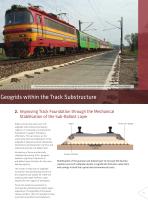
Track reconstruction over low bearing capacity subgrade soils using mechanically stabilised sub-ballast, (Bratislava, Slovakia). x® Geogrids within the Track Substructure 2. Improving Track Foundation through the Mechanical Stabilisation of the Sub-Ballast Layer When constructing track over soft subgrade soils having a low bearing capacity, it is necessary to improve the foundation to support the ballast effectively. This can involve a time consuming chemical stabilisation of the subgrade or deep excavation followed by importation and placement of a thick and expensive granular sub-ballast...
Open the catalog to page 3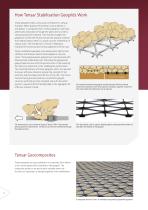
How Tensar Stabilisation Geogrids Work Tensar geogrids make a structural contribution to railway trackbed. When granular fill material, such as ballast or sub-ballast, is compacted over a Tensar geogrid, it partially penetrates and projects through the apertures to create a strong and positive interlock. This interlock enables the geogrid to confine the fill and restrain the granular material from lateral spread, which is a major cause of settlement of railway track. This mechanism is critical in helping to maintain the horizontal and vertical alignments of the rails. Tensar stabiliation...
Open the catalog to page 4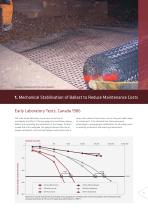
Installation of geogrid within the ballast (Belgium). 1. Mechanical Stabilisation of Ballast to Reduce Maintenance Costs Early Laboratory Tests, Canada 1986 Full scale model laboratory tests were carried out to investigate the effect of Tensar geogrids in stabilising railway ballast and controlling the settlement of the sleeper. On both a weak and a firm subgrade, the geogrid reduced the rate of sleeper settlement such that the sleeper could sustain over 4 times the number of load cycles, across the practicable range of settlements. This indicated that there were great advantages to using...
Open the catalog to page 5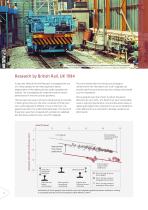
Research by British Rail demonstrated the maintenance benefit of Tensar geogrids. Research by British Rail, UK 1994 In the early 1990s British Rail Research investigated the use of a Tensar geogrid to limit the progressive lateral displacement of the ballast particles under repeated train loading. This investigated the settlement and the rate of deterioration of the vertical track geometry. The full scale trial using a 40 tonne rolling load rig to simulate 2 million gross tonnes on the track, consisted of three tests over a soft subgrade (E=10MPa). In two of the tests, the geogrid was laid...
Open the catalog to page 6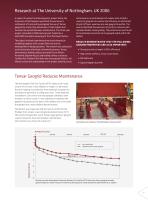
Research at The University of Nottingham, UK 2006 A major UK research and development project led by the University of Nottingham quantified the permanent settlement of track and investigated the use of Tensar geogrids to control the settlement of track ballast and increase the periods between maintenance. The three-year project concluded in 2006 and was part funded by a £250,000 innovation award grant from the Royal Society. Initial work on a small element of railway track tested a variety of geogrids to examine the influence on settlement of grid stiffness, aperture size and geogrid rib...
Open the catalog to page 7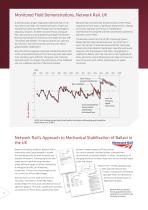
Monitored Field Demonstrations, Network Rail, UK Network Rail has found that the performance of the Tensar stabilised sections shows a significant improvement. Analysis of the data indicates that Tensar is extending the maintenance life compared with the conventional solution by between 2 and 4 times. A demonstration project organised by Network Rail on the busy West Coast Main Line (WCML) between London and Scotland has confirmed the findings from the Nottingham laboratory research. An 800m section of track at Coppull Moor had a history of poor geometry and high maintenance. Network Rail...
Open the catalog to page 8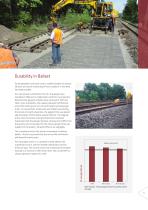
Durability in Ballast Tensar geogrids have been used to stabilise ballast for almost 30 years and some monitoring of their condition, in the field, has been possible. At a site known as Shirland in the UK, the geogrid was installed in 1988 and in collaboration with the track operator Network Rail, geogrid samples were retrieved in 1997 and 2006. Since installation the railway had been trafficked by some 200 million gross tons of both freight and passenger trains. An assessment of abrasion was made by examining the tensile strength properties of a geogrid that was placed approximately 225mm...
Open the catalog to page 9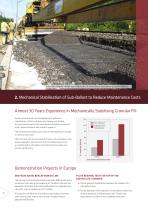
Tensar TriAx™ geogrids installed under the granular sub-ballast layer to increase bearing capacity (Belgium). 2. Mechanical Stabilisation of Sub-Ballast to Reduce Maintenance Costs Almost 30 Years Experience in Mechanically Stabilising Granular Fill Tensar International has developed the mechanical stabilisation of both sub-base and railway sub-ballast. A proven performance has been demonstrated in numerous trials, demonstrations and research projects. The resulting sub-ballast layer will provide significant savings in construction costs. Stabilised with Tensar biaxial The thickness and...
Open the catalog to page 10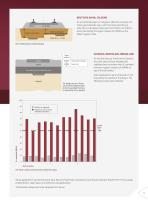
deutsche bahn, cologne Ballast On a monitored project in Cologne in 2003, the inclusion of a Tensar geocomposite over a soft formation permitted a reduction in sub-ballast thickness from 1050mm to 700mm, while maintaining the target modulus of 120MPa as the ballast support value. Non-stabilised and stabilised designs sl ovakia, bratislava-trnava line Target modulus Tensar Mechanically Stabilised Layer On the Bratislava to Trnava line in Slovakia, the client used a Tensar mechanically stabilised layer to achieve the UIC standard minimum support modulus of 50MPa on top of the sub-ballast....
Open the catalog to page 11All Tensar International catalogs and technical brochures
-
Tensar HX
1 Pages
-
Road-Technology
12 Pages
-
TensarTech® EcoCrib™
2 Pages
-
TensarTech® SlopeLoc™
2 Pages
-
TensarTech™ slopeloc™
3 Pages
-
Asphalt Reinforcement
10 Pages
-
Tensar_Erosion_Control
12 Pages
-
Tensar Mining Brochure
8 Pages
-
Tensar General Brochure
20 Pages
-
Tensar Architects Brochure
11 Pages
-
TensarTech Plateau Brochure
6 Pages
-
Tensartech TW1 Wall Brochure
6 Pages
-
TensarTech Stratum Brochure
6 Pages
-
TensarTech Ares
2 Pages
-
Tensar Ballast Stabilisation
2 Pages
-
Tensar Wind Energy Brochure
6 Pages
-
Tensar Erosion Control Brochure
12 Pages
-
Tensar GlasstexPatch 880
2 Pages
-
Tensar Mining Brochure
4 Pages
-
Tensar Railway Brochure
12 Pages
-
Tensar Sub ballast Stabilisation
12 Pages
-
Tensar TriAx Geogrid Brochure
12 Pages
-
TensarTech Stratum
6 Pages
-
Tensar Oil and Gas Brochure
5 Pages
-
TENSAR GEOPIER FOUNDATIONS
8 Pages
-
Tensar Erosion Control
12 Pages
-
Tensar_TriAx_TX
12 Pages
-
Foundations over Piles
6 Pages
-
Basal Reinforcement
6 Pages
-
TensarTech_TW3
6 Pages
-
TensarTech_TW1
6 Pages
-
Tensartech_TR2_System
4 Pages
-
TensarTech_NaturalGreen
6 Pages
-
TensarTech_GreenSlope
6 Pages
-
Tensartech_Geocell_brochure
6 Pages
-
Wind_Energy_Brochure
6 Pages
-
Tensar_Oil_and_gas_brochure
5 Pages
-
Tensar_GlasstexPatch_880
2 Pages
Archived catalogs
-
Tensar_Mining_Brochure
5 Pages
-
Tensartech_TW3
6 Pages
-
Tensar_Sales_Leafle
3 Pages
-
New_Architects
11 Pages
-
Tensartech_Green Slope
6 Pages
-
Tensar Uniaxial Brochure
16 Pages
-
Tensar Basal Reinforcement
8 Pages
-
Tensar Erosion Brochure
2 Pages
-
TriAx brochure 2010
12 Pages
-
Tensar Railways Brochure
12 Pages
-
Tensar General Brochure
20 Pages


















































